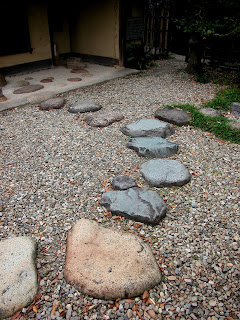Coming Soon!
A current project I am working on is to write an e-book on the art of arranging stones in a Japanese style gardem. I am trying to distill over 30 years of experience of being involved in the creation of this type of gardem. The selection and placement of stones is one of the most crucial aspects of creating such gardens, and the manner in which it is done is key. It is a fascinating subject, and throws a lot of light on the whole aesthetic of such gardens. The book will be a manual for anyone interested in creating a Japanese style garden, and also for any one with a passing interest in the subject.
At present the text is still being laid out, and then will come the work of illustrating the text with photos and diagrams. So far so good, but there is some way to go yet. The book will be made available in a variety of formats. Look out here for further announcements. I will keep you posted when it becomes available.
In the meanwhile keep checking out the blog, and please enjoy a taste....
Ishigumi.
Arranging Stones In A Japanese Style Garden
Stones are a paradox, they appear inert and unyielding, yet
they are capable of expressing movement and so they can move us, and we can
move with them. Their weight and mass connects powerfully with the earth, yet
they seem to soar towards the heavens. They are capable of expressing distance,
depth and seem to stir memory of deepest time, and make connections within own
minds. A stone will occupy and dominate, even define space, become a point
marked, as if punctuation mark in a sentence. A centre, and so according to
Mircea Eliade, becoming something sacred, a voice with something to say. Rock
arrangements suggest something primal, mysterious, yet redolent with continuance.
A voice coming to us borne by the wind, even if the words are indistinct to our
ears. Yet, when we learn to hear those words, what wonderful songs, what
wonderful music it makes.
In Japan the skill of a garden creator
has traditionally been measured by their ability in setting stones.
Master the setting of stones, then the garden will master itself,
that seems to be the line of thought involved with creating gardens in Japan.
It is certainly a characteristic of the Japanese gardens that one notices
almost immediately; the way and manner with which stones are used is very
different to the way they are used in the Western garden. For one thing, stones
are not used to simply create rockery features in gardens, but seem to be
integral to the concept of what a garden is in Japan. The stones arranged in the garden carry meaning as well as
being compositional elements. It is often remarked that the arrangement of
stones form the ‘skeleton’, the underlying infrastructure of the garden
arrangement, and the planting (the more familiar aspect of a garden in Western
eyes) is overlain on top of this structure. Where the planting forms the ‘flesh
over the bones’. There are many garden arrangements in Japan that dispense with
planting altogether, these gardens are usually found in Zen temples, where it
is a characteristic of that particular aesthetic to pare down the design to its
fundamentals, dispensing with anything other than the absolute essential
elements. The world famous garden at Ryoan-ji temple in Kyoto is an example of
this approach, where in the courtyard garden it is composed of fifteen stones
and raked garden, there is no planting apart from a pool of moss at the base of
the stone groups. There are other even more extreme examples one could cite, where
even the stones have been omitted and the garden is simply composed of raked
gravel alone, Tokai-an (Myoshin-ji temple), and Ryugin-an (sub-temple of the
Tofuku-ji complex), both in Kyoto are examples of this approach. In this work
the intention is to examine the role of stone arrangement and see how it
performs in this role of creating a basic structure from which the garden
emerges in its totality. The manner and principles with which stones are
arranged are common to design principles as exhibited in a number of the
Japanese arts, and may also be found in painting, flower arrangement and so on.
In traditional Japanese gardens what the viewer is presented
with is a composed and framed view, or a series of interlocking views. A
critical aspect to the make up a garden view is the placement of stones within
the garden space. The pattern of their interrelationships creates a variety of
'physiological' structures, which are presented in a logical and sequential
order that in turn aids to order the view; so structuring a view, making it
authentic, visually logical and so harmonious to the perception of the viewer.
The garden is rarely revealed in the whole, rather it is presented in such a
way as to allow the viewer to re-create the totality in his or her own imagination.
A view is built up, by the play of layer upon layer of scenery, adding depth
and visual complexity each time. The mind though, seems to fall into a sense of
equilibrium, perceiving movement yet stillness, 'equal play'. What the
mind signals is that it's perceiving is something balanced, something where all
the forms are in harmony. This opens the door for the viewer, now he or she can
become a part of the garden. All manner of landscapes and gardens will have a
similar effect on the experiencing viewer, but the Japanese garden uses this
aspect with a particularly deliberate effect.
To follow this blog:
the 'Follow by E-mail' facility is now operating.
Don't miss a beat and sign in.
Also do not forget to try: http://www.newpages.com/blogs/writers-blogs.htm



































